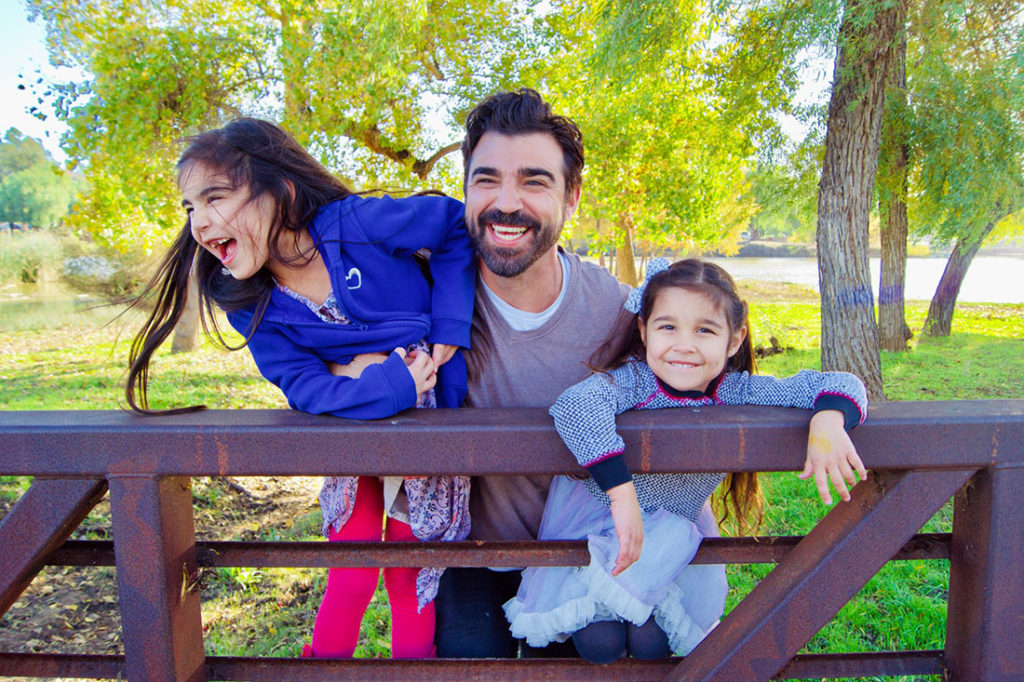I woke up at 5 a.m. in a tent on Pilot Mountain in North Carolina. The sun wasn’t up yet, but the birds—so many birds—united in their attempt to call it out of its slumber.
Unable and uninterested in going back to sleep, I focused my concentration on each particular call. I tried, in vain, to count how many different types of birds were interrupting my sleep. An audience of one, or so I thought, I listened as they sung the world into existence. As it turned out, the audience was bigger than just me.
As I exulted in this chirped performance, my then-5-year-old daughter rolled over and said, “Daddy, it sounds like music!”
My heart could have exploded in my chest. Before that moment, I had been reluctant to take my girls on outdoors trips, especially work trips. I was worried my love of the wilderness would too far outpace theirs and that none of us would have fun. No more. In the years six since then, I have taken my two girls (14 and 11) on all manner of work/travel/adventure assignments. We’ve gone camping, skiing, stargazing, to a hot air balloon race, plus many more.
I take my daughters to work for many reasons. The primary one is fun. I consider it a great blessing that I get to combine work and family on excursions we all enjoy. I’ll keep doing it for as long as they’ll go with me. (Tick-tick goes the clock on that.) I worked for my dad for four summers, and I got to know him in a different way when I saw him interact with people unrelated to his role as my father. I hope some of that happens for my daughters, too. I want them to hear me talk about something other than clean rooms, full dishwashers and bed times.
I hope they learn about the business world, too. I think they have. And in the process, I’ve learned at least as much as they have.
Lesson 1: If you say you’re going to do something, do it.
I stepped outside, and the wind whipped against my shoulders and legs. The ambient temperature was 25, and the wind made it feel much worse. I grew up in Michigan, so normally such temperatures don’t bother me. Then again, normally I’m fully clothed. On this day in early February, I was wearing only shorts and a sleeveless T-shirt (which I thought would be ironically funny and instead just made me that much colder), and I was about to jump in a lake as part of a fundraiser for the Special Olympics.
As good of a cause as that is, my shivers prompted me to question my own judgement. When my 14-year-old said she wanted to do a polar plunge, I thought it was a great idea and encouraged her to do it. The “mistake” I made was when she was having a hard time convincing her friends to do it, I said I would accompany her so she didn’t have to do it alone.
As we stood by the water waiting to rush into it, I was miserably cold but also glad to see my daughter quaking with cold, too. I try to teach my kids to do hard things precisely because they are hard, and she seemed to embrace that ethos.
The emcee prattled on and on. Finally he yelled “go.” I sprinted toward the water, took a few steps into it, then spin-jumped so I flopped onto my back. Next to me, my daughter dove in. The average pool is about 80 degrees. The water temperature of Lake St. Louis was 39.
The shock of hitting the water was sharp, as if someone waxed my entire back at once. My sitting heart rate is 62. In the water, it was 100. But that was not the worst part. The worst part was coming out of the water, when the 25-degree air and icy wind chilled my very bones. As I ran to shore, it felt like someone grabbed the back of my shirt and cinched it tight enough to squeeze the breath out of me.
My daughter turned lobster red. We walked from the beach across concrete to get inside, and every step felt like stepping on nails. We shuffled inside, and gradually the full body pain faded like an echoing mountain yell.
The obvious lesson here is if you say you’re going to do something, do it. I wanted to back out before we left the house, when we stepped outside into the cold, when the emcee talked and talked. But quitting would have been way, way worse than jumping in the water was (and jumping in the water was bad).
My greatest source of frustration as a solopreneur is with clients who say they’re going to do X and then don’t do it. Ghosting has become so commonplace that we had to make up a word for it. I try very hard not to do to others what I don’t want done to me. I’m not perfect at that. But if I can jump into 39-degree water on a 25-degree day, I can hit a challenging deadline.
As cold as it was on the day we did it, the wind chill the following Saturday was negative 17. I’m grateful I didn’t have to keep my promise then.
Sub-lesson: Learn to say “no.” My wife and daughter said, “no way, no how; are you nuts?” when we invited them to join us on the polar plunge. When you are new to the solopreneur life and wondering how you’re going to make ends meet, you will say “yes” to every gig. I encourage you to eventually say “no.” It’s liberating.
Lesson 2: The bottom line is not the most important thing.
I am ashamed to admit this, but upon seeing mice in the living room and kitchen of our cabin in Ohio, my first instinct was to ignore my daughter when she wanted to leave immediately.
It was 10 p.m., we had already spent eight hours in the car, and I needed to sleep. The closest hotel was a 30-minute drive on dirt roads through the mountains. Plus, I had already paid for four nights in the cabin, and based on online reviews of the owner, a refund seemed unlikely. If I had to eat that cost, plus pay for four nights somewhere else, I would barely make any money on that assignment.
I changed my mind and left for a hotel because I don’t want to be the type of dad who prioritizes a better rate over his daughter’s comfort. We left. And I got the refund anyway.
Sub-lesson: Stand up for yourself. Mice in the living room and kitchen of a cabin is unacceptable. If my daughter saw me accepting that, what would she accept that she shouldn’t?
Lesson 3: Remember your why.
I am a journalist in large part because I am passionate about learning about new people, diving into new topics, taking off on new adventures. Whatever the subject, I dive in giddily.
A few years ago, I sold a story for which I documented a summer-long attempt to get my first hole-in-one. One day my girls joined me at the golf course. They skipped across the course as if it was a playground. On the first hole, I had to tell them not to run on the green. I wanted to admonish them to behave. This isn’t a game. Then I realized this was all new to them, and they were showing the same passion I have for something new.
Telling them to calm down would be like telling myself to calm down when I’m embarking on a new experience. “Why can’t I do cartwheels on the green?” one of them asked, and my meager answer sounded so pitiful I won’t repeat it. (Sub-lesson: Don’t take anything so seriously that you can’t laugh at cartwheels.)
Later that summer, the newness of going to the golf course had faded, so I bribed my then 8-year-old with doughnuts to go with me. I made it new again for her by letting her sit in my lap and steer the golf cart while I worked the gas and brakes.
“Daddy, Daddy, he’s our man; if he can’t do it, no one can!” she chanted on one tee box.
A minute later, I got the hole-in-one.
The first thing she said after I stopped yelling about it was “should we call Mommy?” She asked again a minute later. She could not wait to share the news.
“Boy, am I glad I went with you!” she said as we arrived at the green to retrieve the ball. That’s a highlight not only of my career but my entire life.
Lesson 4: Doing hard things enables you to do harder things.
Regrettably, I learned this late in life. If I could tell my younger self one thing, it would be to do more hard things.
I saw the value of this on a ropes course in Colorado while there with my wife and kids on a family vacation assignment. My then 13-year-old daughter was stuck on one of the challenges. She stood on a platform, a bunch of ropes shaped like giant U’s dangled in front of her. To get across, she had to step from one U to the next with nothing but the ropes themselves to hold onto and step on.
She was 20 feet off the ground and strapped in, with no danger of falling and hurting herself. But if she lost her grip or misstepped, she would feel like she was falling even if she really wasn’t. (Sub-lesson: Ask yourself, What’s the worst that could happen? and answer honestly. However bad the challenge you’re facing is, it is never as bad as you think.)
She started, she froze. She started again, froze again. She looked to me for help. But my own attempts at that apparatus ended in failure. I could not do it. I couldn’t teach her or help her; all I could do was encourage her.
She finally figured it out.
The look on her face as she finished… joy, relief, satisfaction, all blended together. I try not to be Overbearing Teachable Moment Dad so I didn’t say anything. I trust that the next time she faces a difficult task, one she thinks she can’t complete, she’ll remember the ropes course.
I know I will.
Read Next: 3 Tips for Solopreneurs to Stay Ahead in a Constantly Changing World
Photo by @TonyTheTigersSon/Twenty20.com










